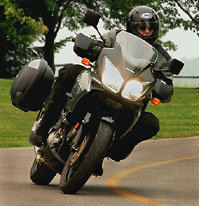 |
| The
V-Strom takes motorcycle usability a step in the right direction. |
With the temperature hovering
in the mid-thirties, I slide the V-Strom to a halt on the delicious
gravel road, somewhere deep in Quebec's Laurentian Mountains. I'd just
crossed one of the many small winding rivers in the area and decided
that it was just too hot to keep riding, especially when a cool fresh
river beckoned for a refreshing dip.
Free of my sweaty Aerostich
suit, I floated around in my new-found Nirvana and wondered why a bike
like the V-Strom doesn't make up ninety percent of the road-going two
wheeled population—-such is its practicability and ability to get
you to this remote slice of prime Canadiana.
But all good things must
come to pass, and as I sat on the bank drying off my toes, the tell-tale
shock of a blackfly taking a chunk of my arse expedited my departure
process. Just like my Quebecian Nirvana, Suzuki's V-Strom has its quirks.
MOTORCYCLE NIRVANA?
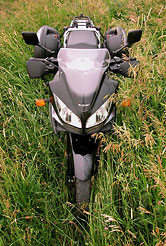 |
| I
dunno. Mr. Seck seemed to like the shot-in-the-long-grass idea |
When the V-Strom appeared
last year I thought "eh up, thar's a bike for me"—a 1000cc
v-twin motor in an adventure-touring-come-roadster chassis. Sensible
(and rather tall) ergonomics, some off-roadability (although Suzuki
like to deny that), and a tried and tested motor. That's what I like
in a bike, and we finally had it in our possession for a good few weeks
in the height of one of last summer’s heat waves.
Although beauty is in the
eye of the beholder, I found the chunky styling a tad questionable,
along with the overall finish—especially around some of the frame
welds. And by sporting cast instead of wire wheels, it's obvious that
the V-Strom is not really meant for much, if any, off-road adventure
(wire wheels have some flex which allows for better shock absorption
in rough terrain, where cast wheels would just permanently deform).
However, it should be noted that Suzuki do not claim, and generally
make a point to the contrary, of any off-road aspirations.
It’s also quite a tall
machine with a seat height of 830mm. At 6’4" I’m quite
happy with the set up, but I reckon that people as tiny as 5’10",
hell, maybe even 5’8", would be fine. So don’t dismiss
this machine on perceived height issues without at least having a sit
on one. The wide bars put you in a bolt upright position, and the tallish
seat gives plenty of room for your legs to stretch out. However, after
a day in the saddle at relatively prompt speeds, I’d end up with
some distinct neck ache and my arse would be really quite sore.
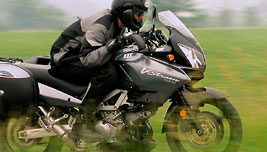 |
| Avoiding
wind buffeting. |
The neck pain could probably
be solved by fitting either the (optional) taller screen—although
the aforementioned shorter types might find the screen fine as is—or
keeping it below 110 km/h, which is where the helmet buffeting would
start. I’m not sure why the V-Strom screen didn’t come with
the Bandit style cut-out at the bottom, which allows for an air blast
to come up on the inside of the screen and so push the main blast up
and over the rider. Seems to work on the Bandit anyway.
Arse pain is an unfortunate
common ‘arris problem (it’s just so very sensitive). However,
this conundrum could be helped by pushing myself back onto the rear
(plush) part of the seat, and/or by using the passenger pegs to allow
for pressure-point variation.
OH THAT V-TWIN MOTOR
 |
| Powerful
motor can be too much on gravel. |
Once underway, the gem of
a motor makes itself quickly apparent. Based on the TL1000S motor that
made its debut in 1997, in V-Strom configuration it’s managed to
lose an alarming 26 horses (now maxing out at 97hp) in favour of low
down and mid range grunt. This is thanks to smaller inlet valves, milder
cam timing and less valve lift.
But that’s not a bad
thing. Above 2,000 rpm it has gobs of torque—a whole 75 ft.lbs
of it to be precise, maxing out right at 6,500 rpm. In fact the torque
onslaught kept it up till the 9,500 rpm redline (cutout comes in at
9,750 rpm), making the bike eager to wheelie if the throttle was applied
hard enough.
Fuel injection was very smooth—something
I’m sure Suzuki spent a lot of time on after the TL problems, likely
thanks to the use of their dual throttle butterfly design, first pioneered
on the GSXR line of bikes. However, it seemed at tad temperamental at
idle speeds, and would occasionally stall out when gearing down, or
just when at idle. It also didn’t particularly like being plodded
along at slow speed in a tall gear (no-go below 3,500rpm in sixth),
but then I suspect that’s not what the motor was designed for.
Then again, having not seen this problem in other write-ups it could
just have been limited to our test model.
The six speed box was quite
usable, but not as smooth as I have come to expect from Suzuki—with
the occasional missed shift and even a false neutral. However, it mysteriously
seemed to behave itself after a few days—either that or I just
got used to it. Sixth is an overdrive gear, which I never used unless
on a main highway, as it would lose too much of that addictive grunt.
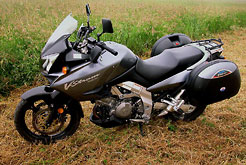 |
| We
eventually got it out of the long grass. |
Although I was expecting
the long travel suspension to cause some vagaries in the handling department,
it was a remarkably tight and well-behaved package. On broken pavement,
or any Quebec road for that matter, it did a great job at isolating
the rider from the war zone below. The wide bars make it easy to drop
in and out of corners, helped by the large aluminum frame and a reasonably
low weight of 207 Kg, making it the lightest in its class to boot.
Braking at the front is by
a pair of 310mm discs, clasped by twin piston calipers. Although not
sportbike spec, they do give great feedback and a firm handful will
result in enough retardation for most situations. By contrast, the back
brake is a bit on the weak side, but as a result will not lock up the
rear too quickly either.
TROUBLE IN PARADISE
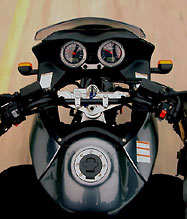 |
| The
view from here. |
As impressive as the V-Strom
is, there is the occasional black-fly in Nirvana:
For starters, although the
V-Strom is a heavy contender on the asphalt (in fact it’s quite
gorgeous), on gravel roads the 1150GS or Tiger would have it beat. Although
it can actually do gravel pretty well, the aggressive power delivery
is a bit of a deficit, causing the back tire to lose grip and slide
out if anything other than a gentle hand was used. Of course, this can
be a load of fun too, but not if you’ve got a lot of dirt road
ahead of you. It also felt a bit vague in gravel corners at the front.
Nothing horrendous, but it reminded me a bit of the older Tiger before
it got its most recent makeover—you just never quite knew what
it was going to do.
There’s also a handy
fuel gauge in the cockpit, which uses five bars to illustrate the remaining
fuel available. However, as seems all too common on these gauges, it
would show full (5 bars) for the first 90Km, then four bars for the
next 60km, dropping another bar every 30 Km thereon. Our tester returned
7.12L/100Km (14Km/L), combined with a 22 litre tank that should give
a range of 310 Km. The fuel warning light invariably came on around
210 km, giving a rather generous reserve of 100 Km.
And finally ...
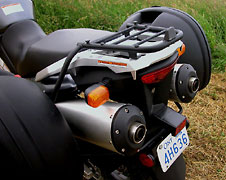 |
| Top
box mount on top of standard rear mount = messy. |
I’m a big fan of hard
luggage. It’s so handy and sensible it’s almost always worth
the extra $. However, the optional Kappa luggage on the V-Strom seems
like a bit of an afterthought. For starters there’s a whole additional
piece of framework to be bolted on the back (it should be integrated
into the existing rack) and then when you put on the bags they stick
out a helluva long way. Okay, it’s not horrendous, but it’s
no better than a do-it-yourself jobbie, and arguably even a little worse.
But wait, there’s more—they’re
also a tad flimsy. This would mean that not everything would line up
when closing and although the locking flaps would do just that—lock—they
wouldn’t always release again. Combine this with the fact that
one of the reflectors on the side-bag’s rear had already fallen
off before we got the bike, and the other then fell off somewhere on
the road during our tenure, I was not exactly impressed.
Oh, and let’s not forget
the top box. When fitted, the passenger not only loses their handy handholds
as the extra mounting frame wraps over them, but the unfeasibly large
‘passenger comfort pad’ on the box itself sticks so far forward
that there’s no room left for the passenger to fit on! The only
time I used it was for myself, and that was when I was riding solo!
The only good thing I can
say about them is that they were big and so could carry lots of stuff.
I’ll not even go into the weave they induced in the bike at 180
Km/h plus.
CONCLUSION
 |
| And
away he went. |
Overall, although I was quite
taken with the V-Strom—especially cutting along at a high rate
of notes down a twisty paved road—I did find more niggly problems
than I had expected. I guess that’s one of the problems of being
the last to get your hands on a certain bike—if it gets rave reviews
from the other mags, you inevitably approach the bike with high expectations
before you’ve even sat on it.
Having said that, the V-Strom
is still a very usable and competent machine, especially when you consider
the list price of $11,699. You get a lot of bike, and at less than $3000
and $5000 than the Triumph Tiger and BMW GS1150 respectively. However,
you also get what you pay for—a less refined package.
Oh, and don’t bother
with the bags.
|